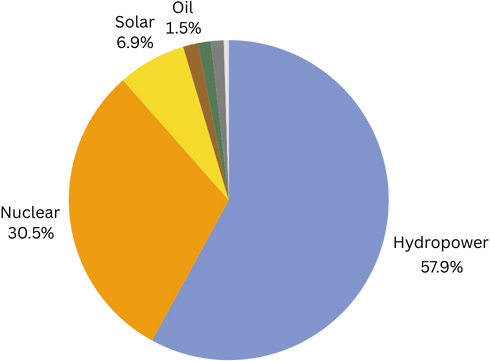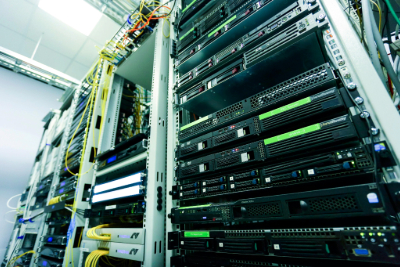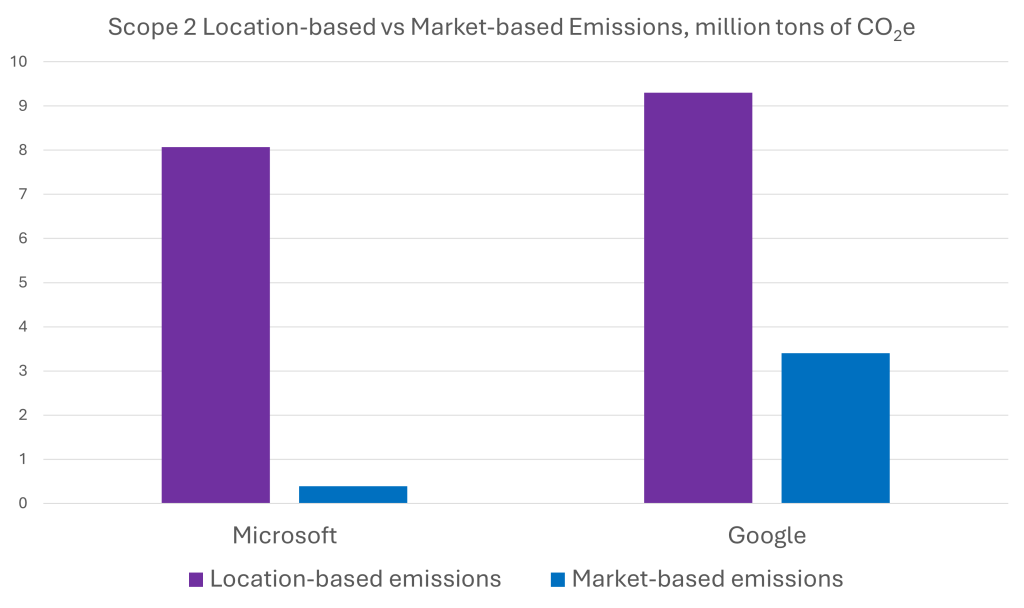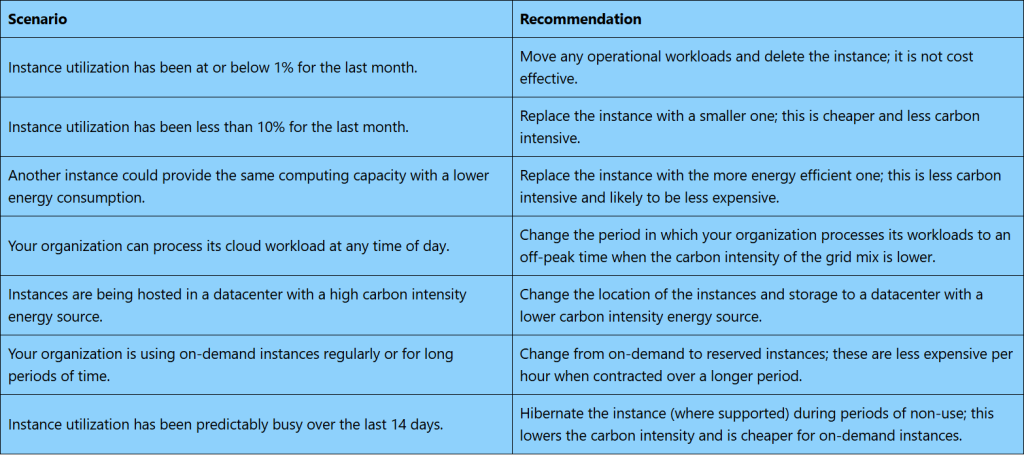
The increasing use of GPUs in cloud computing workloads – and the high energy consumption of these cards – has made accurate measurement of GPU carbon emissions a key aspect of Tailpipe’s methodology for measuring the carbon emissions generated by cloud computing. Tailpipe has built a software for measuring the power draw of GPUs in cloud servers and is delighted to now make the software open source.
It’s important that Tailpipe’s algorithms are as accurate as possible so that organisations can trust the information they receive from Tailpipe and then take the right actions to reduce their cloud computing emissions. As well as carrying out extensive research and using scientific papers and data from computing equipment manufacturers, the Tailpipe team has also been testing servers, measuring the empirical power and comparing those figures with those from Tailpipe’s calculations.
To empirically measure the power draw of servers, Tailpipe utilized the following tools:
In-Line Power Meters – physical boxes that plug into the power supply, before the server plugs into the power meter.
CPU Measurement Software – Teads’ technical team combined Linux applications stress-ng and turbostat to create Turbostress, which can be used to measure the power draw of remote servers using x86 architecture.
GPU Measurement Software – GPU Burn is a multi-GPU CUDA stress tool which, when combined with NVIDIA’s System Management Interface (NVIDIA-SMI), can be used to measure GPU power consumption of remote servers.
However, GPU Burn simply turns the GPU on and off for a specified amount of time, so it’s not helpful for understanding what the power consumption at different levels of GPU utilisation.
So, we decided to create our own software and make it available to everyone. We’ve called it GPU Stress.
GPU Stress is a CUDA-based GPU stress test utility with logging for GPU utilisation, memory usage, and power draw.
When installed and running, it adjusts the GPU power load from 0% to 100% in 5% step increments, each over a 30 second time-period, and then writes the results to a log that can be analysed.
Because you can’t set a precise “run this % GPU utilization” for a GPU, GPU Stress is written so that the average GPU utilization over the 30 second time-period aims to be as close to the relevant target GPU utilization step.
An example set of results from running on an AWS g4dn.xlarge is:

Find Out More
For a more detailed breakdown of how Tailpipe calculates emissions, see the Tailpipe Methodology. For an explanation of how Tailpipe can reduce an organization’s cloud spend and carbon emissions, see Tailpipe’s Recommendations.
To discuss what Tailpipe can do to measure and reduce your cloud computing spend and emissions, get in touch with us here.

In 2020, all the data centers in the world used less than 300 TWh of electricity, or 1% of global energy consumption (MIT, 2025). In 2024, they consumed 415 TWh, reaching 1.5%. By 2030, they are expected to consume 945 TWh – that’s 3% of global electricity consumption (IEA, 2025), and more than the entire aviation industry (IEA, 2025). Why? Because the exponential growth in AI development and usage is more power-hungry than any computing process to come before it.
As the internet becomes increasingly over-saturated with AI content, we must consider: is the environmental cost worth the output?
The Impact of AI on Energy Consumption
Any request using the internet, whether for AI, search engines, web hosting, emails, or streaming, requires energy. The servers that process these requests are housed in data centers powered by electricity. In most countries, this electricity is drawn from fossil fuel powered energy grids, resulting in the release of carbon emissions.
The biggest driver of the increase in data center energy consumption in the past five years has been AI. An AI request today requires almost ten times more electricity than a search engine request (IEA, 2024):
Google search – 0.3 Wh
ChatGPT request – 3 Wh
If AI does drive data center energy consumption to 945 TWh, 2030 will see data center emissions reach 447 million tonnes of CO2e (based on a global grid mix of 473 gCO2e/kWh (Ember, 2024)). To keep global temperatures below the 1.5°C threshold agreed in the Paris Agreement, the world has just 160 billion tonnes of CO2 left to burn through. 447 million tonnes represent 0.3% of that budget – almost as much as the entire population of Brazil emits every year (Our World in Data, 2023).
Why Does it Matter?
As the use of AI skyrockets and associated emissions climb, the internet is becoming ever more saturated with AI content – and this is laying the foundations of a total AI model collapse. In this scenario, the millions of tonnes of CO2 that have (and are yet to be) released into the atmosphere thanks to AI will have been for nothing.
AI model collapse takes place when AI models consume AI-generated content during model training. With more than half of the text on the internet already being AI generated or translated (AWS & UC Santa Barbara, 2024), AI models are currently being trained on a vast pool of non-human content. AI models that are trained on AI content produce poor-quality outputs that become nonsensical after a few iterations of training (Nature, 2024). For example, in this study, when asked about historic church architecture, the first iteration model confused the 18th and 19th centuries, the second iteration hallucinated the existence of a St Peter’s Basilica in Buenos Aires, the sixth iteration responded with nothing but a list of languages, and the tenth iteration answered:
‘In addition to being home to some of the world’s largest populations of black tailed jackrabbits, white tailed jackrabbits, blue tailed jackrabbits, red tailed jackrabbits, yellow.’
Without fresh human-generated training data, or a fundamental change in the way AI works, AI models will continuously degrade. If current trends continue, the 447 million tonnes of CO2e generated by data centers in 2030 could be fuelling an ever more unusable pool of AI generated content.
What Can We Do About It?
Educate individuals about the energy consumption of AI.
The most important first step is for individuals to become aware of how energy intensive AI can be. Most people are unaware that AI – much like search engine queries – even has a carbon impact. In particular, organizations that have adopted AI have a responsibility to educate their employees on the environmental impact of its use.
By quantifying how much energy AI uses in relatable terms, individuals can better weigh up when it is worth using. For example, the 3 Wh of energy needed for a ChatGPT request is about the same as charging a phone to 100% (EnergySage, 2024).
Be selective about how AI is used.
The next step is to consider the most efficient use cases for AI. AI-enhanced processes can be more productive and less energy intensive than a person working alone, usually by cutting down the time it takes for an individual to process information. On the flip side, mandatory AI processes can generate emissions unnecessarily. For example, customer service chatbots that cannot be bypassed when a customer requires input from a real agent, or AI generated content that requires human assessment and editing.
AI tools should be implemented only when their use is shown to be more effective and less energy intensive than an employee working alone.
Consider where your energy is coming from.
One of the most proactive things an organization can do to reduce the carbon emissions of its AI usage is to locate the infrastructure on which it runs, whether owned by the organization or operating in the cloud, in a data center in a location where the electricity used has a low carbon intensity. In most cases, organizations can request that their services are based in specific data centers, with a manageable impact on operationality or cost.
Because data centers are connected to the national grid of the country they are in, the carbon intensity of that country’s or that region’s grid will determine how much carbon the computing processes within that data center produce. For example, cloud services operating through a Norwegian data center will generate far fewer emissions than the same services based in data center on the East Coast of the US, because Norway’s national grid is powered by a much higher percentage of renewable energy sources than that on the US East Coast.
Currently, 45% of the world’s data center capacity belongs to the US, followed by China (MIT, 2025). Unfortunately, these two countries have very carbon intensive grid mixes, with gas being the primary energy source in the US, and coal in China. To stay below the 1.5°C threshold, every country must entirely decarbonize their grids by 2050. Fortunately, many European and South American nations are investing heavily in data center construction, building upon continental grids that are primarily powered by renewables. This is opening up opportunities for organizations to lower their AI emissions by requesting that their cloud services be located in either continent.
Find Out More
If you’re concerned about the impact of AI on your organization’s carbon emissions and would like to quantify and reduce your impact, get in touch with the Tailpipe team here.

We’ve built Tailpipe to make it easy for organizations to measure and reduce the carbon emissions of their cloud computing workloads. Now, with the Tailpipe API, you can bring that same visibility and intelligence directly into your own tools, dashboards, and workflows.
Whether you’re tracking emissions across AWS accounts, integrating with internal reporting systems, or building your own sustainability analytics, the Tailpipe API gives you programmatic access to all the core data: emissions by cloud service, time period, region, and more.
With the Tailpipe API, you can:
Get Started
Explore the full API reference at https://tailpipe.apidocumentation.com/reference – complete with request examples, authentication details, and response formats.
Tailpipe is built for teams that care about both performance and planet. The API makes it easier than ever to embed that ethos into everything you build.
If you’re interested in reducing your cloud computing carbon emissions, get in touch with us here.

How Tailpipe and Common Crawl are Tracking and Reducing Web Crawl Carbon Emissions
At the start of 2025, Tailpipe and Common Crawl teamed up to measure the carbon emissions generated by Common Crawl’s frequent internet-wide web crawl. Common Crawl conducts monthly crawls of the web, adding 3 to 5 billion pages of text to their open-source repository with every crawl. With such a vast quantity of data processing taking place every month, Common Crawl were keen to understand the real-world emissions implications of their crawls.
In collaboration with GreenOps and FinOps consultancy, DigitalPebble, Tailpipe assessed Common Crawl’s AWS usage data for the months of February and March. Tailpipe calculated how many Watts of power Common Crawl’s processes consumed, and the quantity of carbon emissions this power consumption generated. With this information, Common Crawl is equipped to reduce its carbon emissions by identifying areas of over consumption. Our collaboration revealed a fascinating relationship between the different stages of the crawl process and the amount of carbon being emitted.
How Does a Web Crawl Generate Carbon?
Every request in a web crawl is routed through a server in a data center. These servers require electricity, which is drawn from the data center’s local energy grid. If that grid is reliant on fossil fuels as its energy source, every watt of power consumed by the server will require the combustion of fuel, releasing carbon and other greenhouse gases into the atmosphere.
In Common Crawl’s case, most of the servers that their cloud computing is hosted on are based in AWS data centers in North Virginia. The US in this region is primarily reliant on fossil fuels, sourcing 60% of its energy from oil and coal. This means that for every kilowatt-hour of energy that Common Crawl required, 0.39 kilograms of CO2 were released.
How Common Crawl Crawls the Web
First, Common Crawl carries out a ‘seed crawl’, to collect the URLs from which it will launch its web-wide crawl. During the crawl, the crawler scans these URLs for links to other pages and so explores every available page recursively. Web ARChive (WARC) files are created, which store this data. In the final phase, WET (WARC Encapsulated Text) and WAT (WARC Timestamp) files are generated, which store the pages’ text and metadata respectively.

The phases of a Common Crawl web crawl across 20 days.
Findings
From the 1st to the 31st of March, Common Crawl’s use of cloud computing generated 326.4 kgCO2e. That’s the same as driving 1,194 miles in a petrol car.
Of this, 319.5 kilograms were caused by the power draw needed to keep servers responding to Common Crawl’s requests. 6.9 kilograms were ‘embodied’, which means that these emissions were generated during the manufacture of the hardware.
Additionally, Tailpipe identified that 52.5% of Common Crawl’s emissions were due to the power consumption of storage servers (171.4 kgCO2e). The rest was generated by compute requests.

Tailpipe’s emissions data for Common Crawl in March 2025: Total emissions in blue, operational emissions in yellow, embodied emissions in green. Emissions on the right-hand axis are in kilograms of CO2e per day.
Common Crawl’s web crawl takes place across three phases, which can be identified in Tailpipe’s emissions data. The pre-processing phase lasted from the 11th to the 15th of March and caused a spike in power consumption resulting in increased emissions. The fetch phase, from the 15th to the 28th of March, saw emissions stabilize. Finally, the post-processing phase required a small increase in power that heightened emissions for a short period, before dropping off as the crawl concluded.
Overall, Common Crawl’s daily emissions more than double during the 21-day crawl, compared to their non-crawling state.
Phase 1: Pre-Processing
Period: March 11th-14th
Emissions: 44.6 kgCO2e
Phenomenon: A spike in emissions that more than doubles the daily carbon emissions.
Common Crawl started their crawl process on March 11th, with the pre-processing phase. This involves a seed crawl, which collects the URLs that the crawler will use to process each site. It takes around three days to complete the seed crawl.
In this period, we see Common Crawl’s emissions suddenly spike. This is because a huge quantity of compute power is needed to source those URLs, which requires a surge of electrical power to the cloud servers.

Pre-processing phase highlighted in red: Common Crawl’s daily emissions more than double from 6 kgCO2e to 13.4 kgCO2e.
Phase 2: Fetch
Period: March 15th-28th
Emissions: 168.5 kgCO2e
Phenomenon: Emissions stabilize for the duration of the crawl.
On March 15th, Common Crawl started crawling their seed URLs. This involves scanning each URL page for hyperlinks, which are saved and then scanned themselves. The crawled data is stored in a WARC (Web ARChive) format. With up to five billion pages to crawl, this requires a high level of processor utilization that must be fed by a constant power supply. Emissions in this period are therefore maintained at a relatively high level.

Fetch phase highlighted in red: Common Crawl’s emissions stabilize at 13 kgCO2e per day.
Phase 3: Post-Processing
Period: March 28th-31st
Emissions: 53.8 kgCO2e
Phenomenon: Emissions peak slightly before beginning to decrease to pre-crawl level.
In the final phase of the crawl, Common Crawl generates its WET and WAT files. WET files store the plain text embedded in each page, whilst WAT files store every page’s metadata. This requires a small boost of compute and storage capacity for the virtual machines processing the crawl, drawing more power than the fetch phase and resulting in peak emissions of 14 kgCO2e per day.
Once the crawler has made its way through most of the WET and WAT files, the power draw decreases, and emissions start to decline.

Post-processing phase highlighted in red: Common Crawl’s emissions peak at 14 kgCO2e before beginning to decline.
Interestingly, during the post-processing phase, AWS billed Common Crawl less per day, despite emissions (and therefore utilization) increasing. This suggests that Common Crawl’s workload was being consolidated across fewer computing instances with a higher utilization rate than during the fetch phase – we see embodied emissions drop here too, as less physical hardware is provisioned. This demonstrates the importance of efficient resource provisioning, which can bring down costs for an organization.
Before and After the Crawl
For the first ten days of every month, Common Crawl’s emissions stabilize at an average of 6 kgCO2e per day.

Pre-crawl phase highlighted in red: Common Crawl’s day to day use of cloud services generates 6 kgCO2e per day.
These emissions result from the power consumption of servers that are hosting Common Crawl’s Index Server, as well as the everyday background activities of Common Crawl’s developers. Tailpipe’s data shows that Common Crawl’s crawl demands more than twice as much power as the non-crawl operations of its cloud services – therefore generating double the quantity of carbon emissions.
What Common Crawl is Doing to Keep Emissions Low
Despite the sheer enormity of the task that Common Crawl carries out every month, its total emissions – 326.4 kgCO2e – are very low for the scale of its operation. Common Crawl’s low emissions are a result of the cloud services they use being selected with efficiency in mind, and their utilization of the most recent and energy efficient hardware.
As an open-source dataset, Common Crawl also eliminates the need for public or private enterprises and individuals to carry out their own crawls. This means that those 326.4 kgCO2e never have to be generated more than once a month.
Due to the open-source nature of Common Crawl’s dataset, they are subject to copyright restrictions that limit the location of their cloud services to US-based data centers. If they were not subject to these limitations, Tailpipe and DigitalPebble identified that Common Crawl could cut emissions by 90% through migrating their cloud services to a data center that is connected to a lower carbon grid. For example, a Kilowatt Hour of energy consumed by a data center in Sweden produces just 0.02 kgCO2e, compared to the US’ 0.39 kgCO2e. In fact, Common Crawl does utilize a single S3 bucket in a French datacenter already, which generates far lower emissions (0.04 kgCO2e/kWh) than other S3 buckets in the US.
Nonetheless, Common Crawl manages to crawl five billion web pages at a carbon cost of just 326.4 kgCO2e. By providing its data for free, Common Crawl successfully delivers a world-class repository of web data whilst limiting the impact of the internet on the planet.
Find Out More
For a more detailed breakdown of how Tailpipe calculates emissions, see the Tailpipe Methodology. For an explanation of how Tailpipe can reduce an organization’s cloud spend and carbon emissions, see Tailpipe’s Recommendations.
To discuss what Tailpipe can do to measure and reduce your cloud computing spend and emissions, get in touch with us here.

Cloud computing might seem intangible, but it consumes electricity through power grids in exactly the same way as a desktop computer or household fridge.
When you use cloud computing, whether sending an email, streaming video, or backing up data, your request must be transmitted to, and processed by, a physical server in a data center somewhere in the world. These servers require a constant power feed, drawn from the data center’s regional power grid and national power stations.
This means that the location of the data center that carries out your cloud computing services has a significant impact on the quantity of carbon that your usage produces. This is because every country, and sometimes the region within that country, has a different grid mix – the mixture of energy sources that power their electricity supply. This can range from a very low-emission grid mix, made up primarily of renewable energy sources, to a very high-emission mix, that largely utilizes fossil fuels.
Electricity Sources – from cleanest to dirtiest
No country uses a single energy source to generate 100% of their electricity. Instead, they use a combination of different sources, as well as importing electricity from abroad. The UK, for example, generates more than half of its electricity through domestic renewables, a third through gas, and the remainder through imports from Europe (as of March 2025, NESO).
Not all renewables are created equal, however. Although their source might be renewable, the energy generation process for some renewables still produces carbon emissions – “renewable” does not mean zero carbon.

Coal: the most carbon-intensive energy source, producing 970 grams of CO2e for every kilowatt-hour of electricity it generates.
Oil: the combustion of oil produces 720 grams of CO2e per kilowatt-hour of electricity.
Gas: the most common non-renewable in Europe and the US, produces 440 grams of CO2e per kilowatt-hour.
Biomass: the dirtiest renewable energy source, which can produce up to 230 grams of CO2e per kilowatt-hour of electricity, depending on the biomass material being combusted. This can include household waste, wood pellets, livestock byproducts, and sewage sludge.
Solar: produces 53 grams of CO2e per kilowatt-hour, due to the carbon footprint of solar panel manufacturing – but this footprint is paid off after 3 years of usage, with the lifespan of a modern solar panel being up to 40 years.
Hydropower: hydroelectric energy generation is responsible for 24 grams of CO2e per kilowatt-hour, due to the resources needed to maintain hydroelectric dams.
Wind: produces just 11 grams of CO2e per kilowatt-hour, due to the carbon footprint of turbine manufacturing and installation.
Nuclear: the cleanest form of renewable energy, producing just 6 grams of CO2e per kilowatt-hour of electricity. These emissions come from the processing of uranium ore.
Energy source carbon intensities from Our World in Data, 2022.
Clean Grid – Switzerland
There are 109 data centers in Switzerland, including multiple centers run by AWS, Azure, and GCP. With one of the cleanest electricity grids in the world, any cloud computing processed through Switzerland’s data centers will be very low carbon.
Switzerland’s Grid Mix:

Carbon Intensity: 49.49 gCO2e /kWh
An AWS m6a.12xlarge cloud instance with 1TB storage being hosted in a data center in Zurich for a year would produce 102.03 gCO2e.
Grid mix and carbon intensities from Ember, 2024-2025.
Dirty Grid – India
India’s electricity grid is still heavily reliant on fossil fuels, as the second largest consumer of coal in the world. The 152 data centers in India therefore have a very high carbon footprint. At the same time, the low cost of data center hosting in India is making it an attractive prospect for increasing numbers of corporations with heavy cloud computing workloads.
India’s Grid Mix:

Carbon Intensity: 670.86 gCO2e /kWh
An AWS m6a.12xlarge cloud instance with 1TB storage being hosted in a data center in Mumbai for a year would produce 1,107.77 gCO2e. That’s a massive 954% more than exactly the same service based in a Swiss data center!
Grid mix and carbon intensities from Ember, 2024-2025.
Zero Carbon Data Centers – a cloudy issue
Cloud Service Providers (CSPs) recognize that their customers are becoming more aware of the environmental impact of cloud services. AWS, Azure, and GCP have all responded by pledging to run zero carbon operations:
AWS: ‘100% of electricity consumed by Amazon was matched with renewable energy in 2023’.
Azure: ‘By 2025, Azure will shift to 100 percent supply of renewable energy, meaning that we will have power purchase agreements (PPA) for green energy’.
GCP: ‘in 2017, Google became the first company of our size to match 100% of its electricity consumption with renewable energy’.
To truly reach zero-carbon, CSPs would have to generate their own 100% renewable energy over a period of years, or only source electricity from countries with 100% renewable grids (of which there are only a handful). Instead, CSPs meet their zero carbon goals by offsetting their actual emissions with renewable energy power purchases.
CSPs can claim to be zero carbon if they match their fossil fuel energy usage with the purchase of the same amount of renewable energy. This means that whilst CSPs are funding the generation of renewable energy, they are not actually replacing their own fossil fuel consumption with renewables. With cloud computing contributing 1% of global emissions – and rising – (IEA, 2023) it is vital that the actual quantity of carbon emissions being produced by CSPs is kept in check.
The Solution – Data Center Migration
One of the most efficient ways to reduce your organization’s carbon emissions from cloud computing is to migrate your cloud services to a lower carbon data center.
As part of its calculation process, Tailpipe tracks the carbon intensity of all CSP data center locations. It does this by matching CSP regions with country-specific carbon intensity measurements from Ember or other, country-specific, grid mix sources. Tailpipe identifies where your organization’s services are based by analyzing your organization’s usage and billing reports. It then compares the carbon intensity of these locations to the intensities of other data centers around the world, to determine whether to recommend a migration.
Migration of services does not necessarily impact your operationality. It can be completed in-house or with the assistance of your CSP or another service provider. In the case of virtual machines, the attached storage (virtual disks) is replicated to the new data center and then attached to a new server. The old server is then turned off and the new server power on, using the data from the replicated disk. Small workloads can often be moved live, but larger ones can take a period of days. An alternative solution is to switch to more efficient server configurations within the same data center, which will use less power, thereby generating fewer emissions.
Find Out More
To find out more about how Tailpipe factors carbon intensity into its cloud service carbon calculations, see the Tailpipe Methodology. If you’re interested in reducing your cloud computing carbon emissions through efficient data center migration, get in touch with us here.

CO2e Explained
Emissions? CO2? Carbon? GHGs? CO2e?
There is a lot of terminology to describe the global warming effects of human activities, and terms are often used interchangeably. This article will break down the different terms, including the most important one: CO2e.
What are GHGs?
Greenhouse gases (GHGs) are gases which absorb heat, trapping it in the earth’s atmosphere. In low levels, GHGs are vital for keeping the planet at a habitable temperature. However, human industrial activities in the past 150 years have increased the rate at which they are released exponentially. This has led to global warming, as too much heat is contained within the atmosphere.
There are seven GHGs, as defined by the GHG Protocol:
These gases are released in different quantities by different human activities. Some are far more efficient at absorbing heat than others, and some are released in greater quantities. As well as ‘GHGs’ or ‘greenhouse gases’, these gases are often referred to simply as ‘emissions’.
Why is carbon so important?
Carbon dioxide (CO2) is a greenhouse gas produced when organic material, such as gas, oil, coal, and biomass, is burned. It is by far the most common, making up 75% of the greenhouse gases in the atmosphere (Our World in Data, 2024). This is because of the world’s reliance upon fossil fuel generated electricity.
As a result, GHG reduction methods are usually focused on bringing down CO2 emissions. ‘Carbon’ or ‘CO2’ is therefore often used as shorthand for all GHG emissions.
What is CO2e?
Because of the prevalence of CO2 in the atmosphere, all seven greenhouse gases are usually measured in units of CO2e, or ‘carbon dioxide equivalent’. This is a way of describing the impact of each different greenhouse gas in a single unit.
Each GHG has a different global warming potential (GWP). GWP represents the amount of warming a gas can cause over a 100-year period. For example, 1 kg of nitrous oxide traps 273 times more heat than 1kg of carbon dioxide, so nitrous oxide has a GWP of 273. CO2e is therefore calculated by multiplying the amount of one greenhouse gas produced by its GWP. For example, if an activity produces 100 kg of nitrous oxide, this is expressed as 27,300 kgCO2e.
Does cloud computing release greenhouse gases?
Cloud computing primarily produces GHGs through the consumption of fossil fuel generated electricity. However, all seven GHGs are present across the cloud service supply chain.
What does this mean for my organization?
If your organization uses cloud computing services, it will be adding to the emissions of these gases into the earth’s atmosphere. In 2025, organizations of all scales, all around the world, will have to start reporting the amount of CO2e they emit through their use of cloud computing. See Tailpipe’s article, Reporting Cloud Carbon Emissions is Becoming a Legal Requirement, to find out more about how the regulations might affect your organization.
Tailpipe can measure the kilograms of CO2e emitted through your organization’s use of cloud computing, accounting for each greenhouse gas across the entire supply chain. To find out how much CO2e your organization is emitting, and to get tailored recommendations on how to reduce these emissions, get in touch with us here.

Recent research by the Guardian has found that Cloud Service Provider (CSP) emissions are likely to be nearly eight times higher than publicly disclosed.
Carbon emissions from cloud computing are primarily generated through data center power consumption, or operational emissions. CSPs create operational emissions when they purchase electricity from fossil fuel sources, to power their data centers. Whilst CSPs have faced pressure in recent years to reduce their carbon emissions, demand for cloud services has increased. Subsequently, they have resorted to methods of carbon reporting that distribute responsibility away from their own operations. The two primary methods for this are the purchase of renewable energy certificates, and the use of third-party facilities.
As well as energy generation, CSPs also produce emissions in the form of embodied carbon: the emissions generated during the manufacture, transport, and disposal of cloud service hardware. This article focuses specifically on operational emissions; you can read more about embodied emissions in How Does Cloud Computing Create Emissions?.
Renewable Energy Certificates (RECs) prove that energy was generated from renewable sources. However, companies can buy RECs separately from the actual units of power. This means that whilst they fund the renewable energy supplier, there is no obligation to have to use that renewable energy to power their operations. RECs provide companies with green credentials when they can’t – or don’t want to – exchange their fossil fuel energy supply for a renewable one. CSPs are therefore heavily reliant on RECs to fulfil their renewable energy and net zero targets.
This has led to the development of two methods for measuring emissions: location-based and market-based. Market-based emissions include RECs and carbon offsetting certificates: rather than actual emissions, they represent the investment in the renewable energy market that a company has made. Location-based emissions exclude RECs and offsets, and therefore represent the actual emissions generated by the actual power consumption of an organization at that particular location. CSPs are not elusive about their use of RECs: AWS proudly announces in its Sustainability Reports and promotional materials that ‘100% of electricity consumed by Amazon was matched with renewable energy sources in 2023’.
It is also common for CSPs to rent data center facilities from third parties; on average, CSPs generate half of their computing capacity through third-party contracts. Because those third-party organizations pay for the electricity that powers the data centers, CSPs are under no obligation to report the resulting power consumption or emissions generation. This is because such emissions would not be considered Scope 2 (emissions resulting for the purchase of electricity) but Scope 3 (emissions resulting from an organization’s supply chain). Large organizations in most countries are now legally required to report their Scope 2 emissions, but not Scope 3. Third-party data center operators themselves can also decide how to categorize their own power consumption and emissions: some report them as Scope 2, whilst others consider the emissions to be the responsibility of the CSPs that rent from them and therefore class them as Scope 3.
Amazon’s use of RECs and third-party contracting allows it to publicly claim to have achieved the goals of its Carbon Reduction Plan, which began in 2020. In 2020, Amazon’s cloud service, AWS, reported 2,813 tCO2e. In 2023, their use of RECs and third-party contracting meant they could report 0 tCO2e.
The reality was that AWS’ self-reported location-based emission figures more than doubled in that period, from 61,346 to 126,755 tCO2e. This means that AWS is now using more than twice as much fossil fuel generated electricity than in 2020.
That gap between location-based and market-based emissions is replicated in other CSPs’ figures. Microsoft and Google do not report specifically on the emissions of their cloud services. Instead, the graph below shows the difference between the self-reported Scope 2 location-based and market-based emissions of all of Microsoft and Google’s operations – the main source of which is data centers, but which also includes office space.

Sources: Microsoft’s 2024 Environmental Sustainability Report Data Fact Sheet and Google’s 2024 Environmental Report. Amazon/AWS is not included in this graph because their data covers only their cloud service; Microsoft and Google’s data covers all aspects of their operations.
Despite growing awareness of the carbon impact of data centers, their electricity consumption is expected to increase by 600% over the next ten years (National Grid, 2024). This will be driven primarily by a rapid expansion in the use of AI. The processes required to deliver AI services are far more energy intensive than traditional computing and cloud services: one query to ChatGPT requires 25 times more electricity than a ‘traditional’ Google search query (Brussels Times, 2024).
In response, governments and international bodies around the world are racing to implement carbon regulations that may curb the impact of increased computing power consumption. From 2025, the EU’s Corporate Sustainability Reporting Directive will require organizations to report Scope 3 emissions, bringing cloud computing emissions in-scope for the first time. Countries in markets around the world, including the UK, Japan, Australia, China, Brazil, and Canada, are all developing their own mandatory Scope 3 reporting regimes. These regulations will put pressure on CSPs to report the full scope of their emissions. It will also require the users of their cloud services to take accountability for their contribution to those emissions.
Tailpipe calculates the actual, location-based emissions of an organization’s use of CSP services. It does so by determining the power consumption of an organization’s cloud computing services, and factoring in the carbon intensity of the energy sources powering the data centers in which the organization’s cloud services are based. This generates an accurate, transparent, and comprehensive report into an organization’s Scope 3 cloud emissions. Tailpipe then recommends methods to reduce an organization’s cloud emissions, as well as cost-savings.
To find out more about how Tailpipe can help with your Scope 3 reporting requirements, operational carbon emissions, and cloud spend, get in touch with our team here.

In 2025, many organizations will have to start reporting their cloud computing carbon emissions.
This change is indicative of a wider expansion to the regulations that require organizations – small, medium, and large – to report the carbon emissions that they produce. Around the world, but particularly in the EU and UK, governments are preparing legislation that requires businesses to report not only on scope 1 and 2 emissions, but scope 3 as well.
Cloud computing emissions must soon be reported by businesses.
Carbon emissions from cloud computing fall under scope 3 of the Greenhouse Gas Protocol (GHG Protocol). The GHG Protocol is an internationally recognized standard for carbon emission measurement and is used as the foundation for most national and international emissions reporting regulations. The GHG Protocol defines three categories of emissions that businesses might produce:
Scope 1: Emissions from sources that an organization owns or operates (such as gas boilers, on-site mechanical combustion, and fuel for fleet vehicles).
Scope 2: Emissions from the purchased electricity an organization powers its operations with.
Scope 3: Emissions from all other activities outside of Scopes 1 and 2. This includes all emissions from the production of a company’s goods and services, as well as logistics, disposal, employee commuting, business travel, and investments.
Scope 3 emissions make companies responsible for the actions that cause emissions across their supply chains. The category prevents companies from outsourcing their emissions to other organizations or avoiding the bulk of their carbon responsibility: scope 3 contributes approximately 70% of an organization’s emissions (CDP, 2024).
Cloud computing emissions fall under scope 3 because they are produced as a result of an organization’s actions. The organization does not actively burn fossil fuels or pay for the electricity that powers the cloud service, but the emissions are produced regardless. Because that quantity of emissions would not exist without the organization’s use of cloud services, the organization must take responsibility for them.
Small, medium, and large EU and non-EU organizations may be in-scope.
The EU’s Corporate Sustainability Reporting Directive comes into force in 2025, requiring many organizations based in or trading in the EU to report all scope 3 emissions. Those that will be in-scope include:
In addition, large companies based or trading in the EU will also have to conduct due diligence into their scope 3 responsibilities under the Corporate Sustainability Due Diligence Directive from 2027.
This expansion of EU regulation is reflective of changing attitudes towards scope 3 reporting in other countries, especially the UK. In 2023, the UK government launched a Call for Evidence to assess the practicalities of introducing mandatory scope 3 reporting for UK businesses. This was followed up in 2024 by the announcement that the government supports the introduction of IFRS Sustainability Disclosure Standards into UK law, which would require scope 3 reporting. Similarly, countries such as Japan, Australia, China, Brazil, and Canada are all in the process of implementing mandatory Scope 3 reporting regimes.
Datacenter emissions may be 662% higher than Cloud Service Providers state.
Few organizations are prepared for the changes to come. Many are not even aware that cloud computing is in-scope of scope 3 reporting requirements. Additionally, the data that is available from cloud service providers such as AWS, Microsoft, and Google is highly questionable: a September 2024 Guardian report found that datacenter emissions are likely to be up to 662% higher than publicly stated. This puts organizations at risk of regulatory punishment if the data they are reporting comes from inaccurate sources – particularly in light of the EU’s due diligence legislation.
Tailpipe offers an independent and thorough analysis of an organization’s scope 3 cloud computing emissions. Its methodology is comprehensive, transparent, and most importantly, accurate. To find out more about how Tailpipe can prepare your organization for increasing regulatory oversight, get in touch with our team here.

Few organizations truly understand the quantity of carbon emissions they are producing through their use of cloud computing. Cloud service providers’ cloud carbon calculators are part of the problem.
Cloud computing alone already produces half the level of global emissions of the aviation industry (IEA, 2024), through a vast network of energy-intensive data centers. However, the detachment between user and data center that cloud services facilitate means that cloud computing carbon emissions are, to many organizations, an unknown unknown. For an organization to be truly accountable for its environmental impact, it must recognize, account for, and reduce all carbon emissions it is responsible for, including through cloud computing.
The three major cloud service providers (CSPs) – Amazon Web Services (AWS), Microsoft Azure, and Google Cloud Platform (GCP) – all offer cloud carbon calculator tools. These tools enable their customers to understand the carbon emissions that have been emitted as a consequence of their use of the cloud computing services. There are varying degrees of quality between CSPs’ carbon tools, and shortcomings can be identified across five critical areas: accuracy, completeness, granularity, timeliness, and recommendations.
Accuracy
The most important aspect of a carbon emissions calculation is accuracy. To assess a CSP’s carbon calculator accuracy, their methodology must be made publicly available. AWS and Azure both utilize a customer distribution method, allocating responsibility for emissions proportionally to a customer’s usage as a percentage of all of their customers’ usage. This does not account for the wildly varying levels of emissions for different cloud services that utilize different hardware. AWS also utilizes a market-based calculation methodology, which allows them to report reduce carbon emission levels based on their carbon offsetting and renewable energy projects, regardless of the actual emissions of customer energy consumption. GCP uses a more refined methodology based on the percentage of CPU time used by the customer’s service per hour, broadly in line with Tailpipe’s methodology.
Tailpipe’s Grading: Accuracy
AWS | C | Show your working! |
Azure | B | More detail needed. |
GCP | A | Good work! |
Completeness
A complete calculation of carbon emissions will consider both operational (Scope 1 and 2) and embodied (Scope 3) emissions, accounting for the various factors that contribute to both categories. AWS does not account for any embodied emissions in their calculation. Azure and GCP both account for operational and embodied emissions, but across different definitions.
Azure covers:
Scope 1 – diesel fuel and fugitive emissions from cooling.
Scope 2 – direct power consumption used to power the data centers that Microsoft leases and owns.
Scope 3 – raw material extraction, select component aggregation, and end-of-life management.
GCP covers:
Scope 1 – all fossil fuels combusted on-site and fugitive emissions from cooling.
Scope 2 – direct power consumption used to power GCP hardware in facilities that Google leases and owns, and in facilities owned by others.
Scope 3 – Upstream lifecycle of data center hardware and buildings, business travel and commuting associated with data center employees, and the extraction, production, and transportation of fuels used to generate grid electricity.
Tailpipe’s Grading: Completeness
AWS | D | You haven’t answered the question… |
Azure | B | More detail needed. |
GCP | A | Good work! |
Granularity
When it comes to granularity, no CSP provides a breakdown of their final emissions at the component level. Azure and GCP both provide some granularity by delivering separate carbon emission figures for Scope 1, 2, and 3. AWS delivers its emissions figures broken down across service (EC2, S3, or Other) and location (AWS Region). This means that customers cannot tell which operational aspects of their cloud computing usage – such as storage, networking, or memory – are contributing to most of their emissions.
Tailpipe’s Grading: Granularity
AWS | B | More detail needed. |
Azure | B | More detail needed. |
GCP | B | More detail needed. |
Timeliness
The data that CSPs provide can have a long latency. In AWS’s case, data is updated with a 3 month lag. Azure and GCP both deliver data on a monthly basis. This can prevent customers from being able to assess the carbon effectiveness of their operations in a timely manner. It can also interfere with customers’ legal or voluntary emissions reporting deadlines.
Tailpipe’s Grading: Timeliness
AWS | D | Must try harder. |
Azure | B | Good, but you could work faster. |
GCP | B | Good, but you could work faster. |
Recommendations
Having delivered a carbon emission figure, only GCP suggests how a customer could then reduce their carbon emissions. AWS and Azure do not. This, in addition to the lack of granularity, means that the carbon figures delivered to customers by AWS and Azure have little practical viability – they cannot be translated into action to reduce carbon. All three CSPs do provide their customers with rightsizing data to help them find the most cost-effective solution to their cloud computing needs. However, no CSP cross references this cost effectiveness against carbon effectiveness, meaning that customers must decide for themselves whether to prioritize carbon or cost.
Tailpipe’s Grading: Recommendations
AWS | D | Must try harder. |
Azure | D | Must try harder. |
GCP | B | More detail needed. |
Example: AWS’ Customer Carbon Footprint Tool
As an example, compare the carbon emission figure that AWS provides for Tailpipe’s own cloud services, to the one Tailpipe calculates for itself. Tailpipe has been utilizing 12 AWS EC2 instances since January 2024. AWS claims that Tailpipe’s use of its cloud computing services from January 2024 to June 2024 (the latest date that AWS provides data for) is 0 kgCO2e. In contrast, Tailpipe’s own figure for just the month of September 2024 is 30.18 kgCO2e. This would suggest that from January to June 2024, Tailpipe’s use of cloud computing generated approximately 181.08 kgCO2e. See Tailpipe’s Emissions Explained for a breakdown of how this figure was calculated.
The only way that AWS’s figure of zero carbon emissions could be correct is if 100% of the energy that AWS used to power its data centers in that period came from renewable energy sources. Tailpipe is able to map that its use of cloud services was hosted from data centers in the AWS Regions of Virginia, Stockholm, London, and Ireland, which have energy grids that range from very carbon intensive to very sustainable. AWS states that as of 2023, ‘all of the electricity consumed by Amazon’s operations, including its data centers, was matched with 100% renewable energy’.
This allows AWS to claim that Tailpipe’s use of cloud computing produced no emissions – but matching renewable energy is not the same as using renewable energy. AWS matches renewable energy by investing in renewable energy sources worldwide that produce the same number of gigawatts of low-or-no carbon energy as they operationally consume through fossil fuel energy sources. This means that Tailpipe’s use of cloud services released CO2 into the atmosphere, regardless of the renewable energy generation that was funded elsewhere by AWS.
Tailpipe as a Solution
Tailpipe was developed to address each of the five issues that CSP carbon calculators present, providing customers with accurate, complete, granular, timely, and actionable data on the carbon emissions resulting from their use of cloud services. Tailpipe’s comprehensive methodology is publicly available, ensuring full transparency, and accounts for the broad spectrum of cloud computing hardware and use cases.
Tailpipe then delivers granular results at the component and service level, using hourly data as a basis and aggregating to a daily view. With these results, Tailpipe provides tailored recommendations that help organizations reduce their carbon emissions and cloud spend. These recommendations are provided on a sliding scale that can prioritize carbon and cost effectiveness in relation to one another.
In addition, whilst Tailpipe currently supports AWS, it is developing a multi-cloud comparison system that will allow customers to compare the carbon emissions – and cost – of the same services across AWS, Azure, and GCP. With Tailpipe’s insights, organizations can take accountability for their emissions, saving money and reducing emissions simultaneously.
To find out what Tailpipe can do to measure and reduce your cloud computing spend and emissions, get in touch with us here.
Accurate measurement, efficient reductions. To reduce your cloud spend and carbon emissions, Tailpipe will suggest tailored recommendations based on your organization’s specific cloud usage.
These recommendations are based on four principles:
There are seven ways in which these recommendations can be catered to an organization’s specific cloud computing needs:

Implementing Tailpipe’s recommendations can reduce operational cloud costs by up to 25% and carbon emissions by up to 33%. Tailpipe only suggests recommendations that will not compromise an organization’s operational efficiency, so you can be confident that your cloud computing services will continue without interruption, costing your organization less and producing less carbon.
To discuss what Tailpipe can do to measure and reduce your cloud computing spend and emissions, get in touch with us here.
